Book contents
- Frontmatter
- Contents
- Acknowledgements
- Contributors
- Part I Introduction
- Part II Islam across Borders
- Part III Malaysia
- 5 Legal-Bureaucratic Islam in Malaysia: Homogenizing and Ringfencing the Muslim Subject
- 6 The Letter of the Law and the Reckoning of Justice among Tamils in Malaysia
- 7 Islamization and Ethnicity in Sabah, Malaysia
- Part IV Indonesia
- Part V Muslim Minorities
- Index
6 - The Letter of the Law and the Reckoning of Justice among Tamils in Malaysia
from Part III - Malaysia
Published online by Cambridge University Press: 21 October 2015
- Frontmatter
- Contents
- Acknowledgements
- Contributors
- Part I Introduction
- Part II Islam across Borders
- Part III Malaysia
- 5 Legal-Bureaucratic Islam in Malaysia: Homogenizing and Ringfencing the Muslim Subject
- 6 The Letter of the Law and the Reckoning of Justice among Tamils in Malaysia
- 7 Islamization and Ethnicity in Sabah, Malaysia
- Part IV Indonesia
- Part V Muslim Minorities
- Index
Summary
The transformation of land usage in Malaysia has been inextricably linked to a politicizing of Islam and Malay rights. In short, the development of the prime industrial and, hence, subsequent residential heartlands of this nation have taken on an ethno-nationalistic urgency, given the politics of identity within this nation. More specifically, the transformation of key lands in and around Kuala Lumpur, Selangor, and the entire Klang Valley, has not only been crucial for economic reasons, but has also figured large in symbolic intent. For these lands, formerly populated mainly by Tamils and Chinese (Kahn 2006), have become the symbolic heartland of a new and politically unified Malay identity (King 2008; Kahn 2006; Bunnell 2004; Hoffstaedter 2008). The developments of Putrajaya and Shah Alam, in particular, have been focal, not only in creating a large urban (and suburban) Malay populace, a key goal of Malaysian developmentalism spearheaded by former Prime Minister Mahathir Mohamad, but also in crafting the semiotics of a new Malay identity. This new Malay identity, as many scholars have noted, is crafted through an emphasis on Islamic modernism fused with nostalgic imaginings for past Islamic civilizations. On the one hand, we see the intense modernity of the Petronas Towers, and the pride for Islam and Malay identity that Mahathir Mohamad sought in their grandiose erection. On the other hand, we witness the neo-Indo-Saracenic splendour of Putrajaya, the new administrative capital, which also incorporates Mughal, Arab, and Ottoman (King 2008) styles liberally into what is supposed to be a Malay icon of the nation. Musings about the alienating aspects of this architecture notwithstanding,1 the story that is often not told is of the Tamil plantation workers,2 who, in particular, have been dispossessed of their former lands throughout this process.3 In this essay, I focus not on plantation ethnography itself (Nagarajan 2004; Bunnell, Nagarajan and Willford 2010), but on the political and psychological effects of plantation retrenchments and dislocations.
- Type
- Chapter
- Information
- Encountering IslamThe Politics of Religious Identities in Southeast Asia, pp. 133 - 157Publisher: ISEAS–Yusof Ishak InstitutePrint publication year: 2012



